| The Sirens | |
|---|---|
 | |
| Artist | Auguste Rodin |
| Year | 1887 |
The Sirens, The Sirens' Song or Nereids is an 1887 bronze sculpture with a brown patina. It was created by Auguste Rodin and cast by the Rudier Foundry.
| The Sirens | |
|---|---|
 | |
| Artist | Auguste Rodin |
| Year | 1887 |
The Sirens, The Sirens' Song or Nereids is an 1887 bronze sculpture with a brown patina. It was created by Auguste Rodin and cast by the Rudier Foundry.
He also used the figure on the top left of The Gates of Hell and it also formed the inspiration for his The Poet's Death and his work on the Vittorio Emmanuele II Monument. The work is alluded to in Victor Hugo's play Cromwell , when Rochester remarks to Francisca "My queen, my goddess, my nymph, my siren!". [1]

François Auguste René Rodin was a French sculptor, generally considered the founder of modern sculpture. He was schooled traditionally and took a craftsman-like approach to his work. Rodin possessed a unique ability to model a complex, turbulent, and deeply pocketed surface in clay. He is known for such sculptures as The Thinker, Monument to Balzac, The Kiss, The Burghers of Calais, and The Gates of Hell.

The Thinker is a bronze sculpture by Auguste Rodin, usually placed on a stone pedestal. The work depicts a nude male figure of heroic size sitting on a rock. He is seen leaning over, his right elbow placed on his left thigh, holding the weight of his chin on the back of his right hand. The pose is one of deep thought and contemplation, and the statue is often used as an image to represent philosophy.

The Gates of Hell is a monumental bronze sculptural group work by French artist Auguste Rodin that depicts a scene from the Inferno, the first section of Dante Alighieri's Divine Comedy. It stands at 6 metres high, 4 metres wide and 1 metre deep (19.7×13.1×3.3 ft) and contains 180 figures.

The Walking Man is a bronze sculpture by the French sculptor Auguste Rodin. This sculpture was made in 1907.

Cybele is a sculpture by French artist Auguste Rodin. It is one of the first of Rodin's partial figures known as "fragments" to be displayed as sculpture in its own right, rather than an incomplete study.

Brother and Sister is an 1890 bronze sculpture by Auguste Rodin.
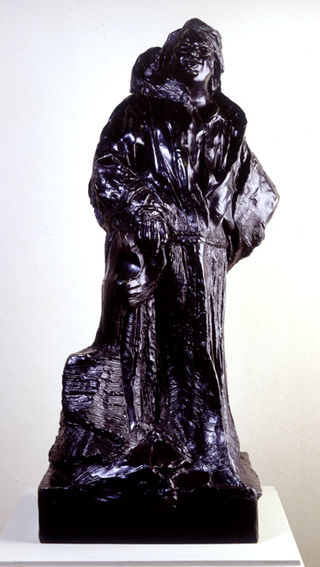
Balzac in the Robe of a Dominican Monk is a bronze sculpture by French artist Auguste Rodin, one of the studies made in preparation to the Monument to Balzac, a tribute to novelist Honoré de Balzac commissioned by the Society of Men of Letters of France in 1891.
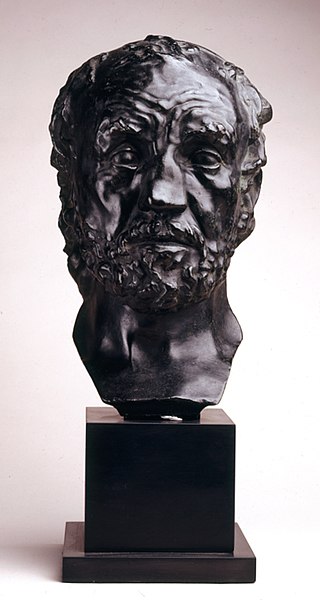
Man with the Broken Nose is a sculpture by Auguste Rodin created between 1863 and 1864 and approved by the Salon in 1875. It is considered the first by Rodin in which life is represented over the grace pervading the academic circles and aesthetic of the time.

Fugitive Love is a sculpture by Auguste Rodin made between 1886 and 1887, both sculpted in marble and cast in bronze. It represents a man and a woman embracing each other on top of a rock. More specifically, the author was inspired by the story of Francesca da Rimini's love affair with Paolo Malatesta, an allusion to Dante Alighieri's depiction of lust on the second circle of Hell in his Inferno.
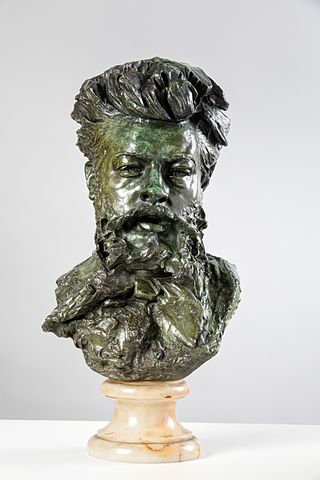
The Bust of Maurice Haquette is an 1883 bronze sculpture by the French artist Auguste Rodin, measuring 53.5 by 26.7 by 41.1 cm.

The Athlete is a 1901-1904 black-patina bronze sculpture by the French artist Auguste Rodin It measures 39,4 × 27,5 × 24,3 cm.

The Maiden Kissed by the Ghost is an 1880 sculpture by the French artist Auguste Rodin. It was first exhibited at his fourteenth exhibition, hosted by the National Society Salon. One of the marble versions of the work is now in the Museo Soumaya in Mexico City.

The Succubus is a bronze sculpture with a green and dark brown patina. It was originally conceived in 1889 by the French artist Auguste Rodin as part of a set of works showing sirens and Nereids. It later formed part of his state-commissioned monument to Victor Hugo. It is now in the Museo Soumaya in Mexico City.
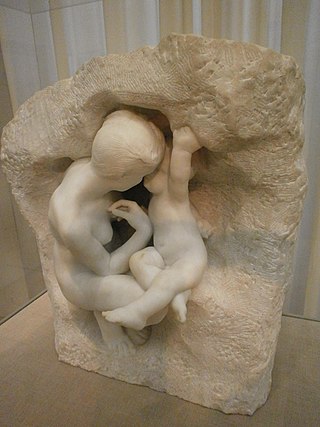
Young Mother in the Grotto or Woman and Love is a sculpture by Auguste Rodin, conceived in plaster around 1885. It was first exhibited at the Paris Salon of 1885. John Tweed was very close to Rodin and Young Mother was a strong influence on his 1894 Mother and Child.

Youth Triumphant is one of the sculptures created by Auguste Rodin as part of the planning for his The Gates of Hell. It was inspired by Jean Dampt's The Grandmother's Kiss, exhibited in 1893. That work shows a young woman resting in the arms of an old woman, with the pair deeply kissing.
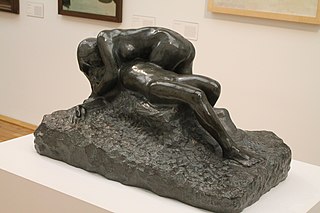
The Death of Adonis is a white marble sculpture. It was created by Auguste Rodin and signed “A RODIN” on the base. It shows Aphrodite mourning over the body of Adonis. The main version is in the Musée Rodin and another is in the Museo Soumaya.

Damned Women is a sculpture created by Auguste Rodin between 1885 and 1890 as part of his The Gates of Hell project—it appears on the upper right as the counterpart to The Fallen Caryatid.

Suzon is an early bust of a woman by Auguste Rodin, created between 1872 and 1873 when he wholly worked on commissions. It was inspired by late 18th century Romantic works whilst Rodin was in exile in Brussels due to the Franco-Prussian War. He created it in homage to Albert-Ernest Carrier-Belleuse, another sculptor also in exile there who was highly influential on Rodin's early works.

Torso of Adele is an 1878-1884 sculpture by the French artist Auguste Rodin, originally modelled in plaster before being worked in terracotta.

Adam is an 1880-1881 statue of Adam by Auguste Rodin, first exhibited at the Paris Salon that year entitled The Creation of Man.